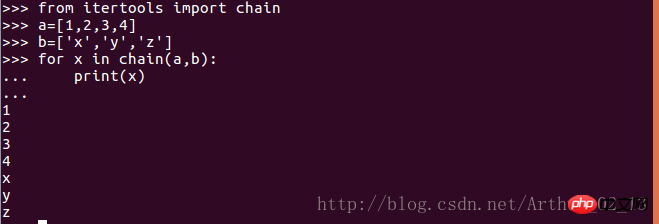Python中迭代器与生成器实例详解
这篇文章主要介绍了Python 中迭代器与生成器实例详解的相关资料,需要的朋友可以参考下
Python 中迭代器与生成器实例详解
本文通过针对不同应用场景及其解决方案的方式,总结了Python中迭代器与生成器的一些相关知识,具体如下:
1.手动遍历迭代器
应用场景:想遍历一个可迭代对象中的所有元素,但是不想用for循环
解决方案:使用next()函数,并捕获StopIteration异常
def manual_iter():
with open('/etc/passwd') as f:
try:
while True:
line=next(f)
if line is None:
break
print(line,end='')
except StopIteration:
pass#test case items=[1,2,3] it=iter(items) next(it) next(it) next(it)
2.代理迭代
应用场景:想直接在一个包含有列表、元组或其他可迭代对象的容器对象上执行迭代操作
解决方案:定义一个iter()方法,将迭代操作代理到容器内部的对象上
示例:
class Node:
def init(self,value):
self._value=value
self._children=[]
def repr(self):
return 'Node({!r})'.fromat(self._value)
def add_child(self,node):
self._children.append(node)
def iter(self):
#将迭代请求传递给内部的_children属性
return iter(self._children)#test case
if name='main':
root=Node(0)
child1=Node(1)
child2=Nide(2)
root.add_child(child1)
root.add_child(child2)
for ch in root:
print(ch)3.反向迭代
应用场景:想要反向迭代一个序列
解决方案:使用内置的reversed()函数或者在自定义类上实现reversed()
示例1
a=[1,2,3,4] for x in reversed(a): print(x) #4 3 2 1 f=open('somefile') for line in reversed(list(f)): print(line,end='') #test case for rr in reversed(Countdown(30)): print(rr) for rr in Countdown(30): print(rr)
示例2
class Countdown:
def init(self,start):
self.start=start
#常规迭代
def iter(self):
n=self.start
while n > 0:
yield n
n -= 1
#反向迭代
def reversed(self):
n=1
while n <= self.start:
yield n
n +=14.有选择的迭代
应用场景:想遍历一个可迭代对象,但是对它开始的某些元素并不感兴趣,想跳过
解决方案:使用itertools.dropwhile()
示例1
with open('/etc/passwd') as f:
for line in f:
print(line,end='')示例2
from itertools import dropwhile
with open('/etc/passwd') as f:
for line in dropwhile(lambda line:line.startwith('#'),f):
print(line,end='')5.同时迭代多个序列
应用场景:想同时迭代多个序列每次分别从一个序列中取一个元素
解决方案:使用zip()函数




6.不同集合上元素的迭代
应用场景:想在多个对象执行相同的操作,但是这些对象在不同的容器中
解决方案:使用itertool.chain()函数

7.展开嵌套的序列
应用场景:想将一个多层嵌套的序列展开成一个单层列表
解决方案:使用包含yield from语句的递归生成器
示例
from collections import Iterable
def flatten(items,ignore_types=(str,bytes)):
for x in items:
if isinstance(x,Iterable) and not isinstance(x,ignore_types):
yield from flatten(x)
else:
yield x#test case items=[1,2,[3,4,[5,6],7],8] for x in flatten(items): print(x)
Atas ialah kandungan terperinci Python中迭代器与生成器实例详解. Untuk maklumat lanjut, sila ikut artikel berkaitan lain di laman web China PHP!

Alat AI Hot

Undresser.AI Undress
Apl berkuasa AI untuk mencipta foto bogel yang realistik

AI Clothes Remover
Alat AI dalam talian untuk mengeluarkan pakaian daripada foto.

Undress AI Tool
Gambar buka pakaian secara percuma

Clothoff.io
Penyingkiran pakaian AI

AI Hentai Generator
Menjana ai hentai secara percuma.

Artikel Panas

Alat panas

Notepad++7.3.1
Editor kod yang mudah digunakan dan percuma

SublimeText3 versi Cina
Versi Cina, sangat mudah digunakan

Hantar Studio 13.0.1
Persekitaran pembangunan bersepadu PHP yang berkuasa

Dreamweaver CS6
Alat pembangunan web visual

SublimeText3 versi Mac
Perisian penyuntingan kod peringkat Tuhan (SublimeText3)

Topik panas
 1378
1378
 52
52
 PHP dan Python: Membandingkan dua bahasa pengaturcaraan yang popular
Apr 14, 2025 am 12:13 AM
PHP dan Python: Membandingkan dua bahasa pengaturcaraan yang popular
Apr 14, 2025 am 12:13 AM
PHP dan Python masing -masing mempunyai kelebihan mereka sendiri, dan memilih mengikut keperluan projek. 1.PHP sesuai untuk pembangunan web, terutamanya untuk pembangunan pesat dan penyelenggaraan laman web. 2. Python sesuai untuk sains data, pembelajaran mesin dan kecerdasan buatan, dengan sintaks ringkas dan sesuai untuk pemula.
 Bagaimana Debian Readdir Bersepadu Dengan Alat Lain
Apr 13, 2025 am 09:42 AM
Bagaimana Debian Readdir Bersepadu Dengan Alat Lain
Apr 13, 2025 am 09:42 AM
Fungsi Readdir dalam sistem Debian adalah panggilan sistem yang digunakan untuk membaca kandungan direktori dan sering digunakan dalam pengaturcaraan C. Artikel ini akan menerangkan cara mengintegrasikan Readdir dengan alat lain untuk meningkatkan fungsinya. Kaedah 1: Menggabungkan Program Bahasa C dan Pipeline Pertama, tulis program C untuk memanggil fungsi Readdir dan output hasilnya:#termasuk#termasuk#includeintMain (intargc, char*argv []) {dir*dir; structdirent*entry; if (argc! = 2) {
 Python dan Masa: Memanfaatkan masa belajar anda
Apr 14, 2025 am 12:02 AM
Python dan Masa: Memanfaatkan masa belajar anda
Apr 14, 2025 am 12:02 AM
Untuk memaksimumkan kecekapan pembelajaran Python dalam masa yang terhad, anda boleh menggunakan modul, masa, dan modul Python. 1. Modul DateTime digunakan untuk merakam dan merancang masa pembelajaran. 2. Modul Masa membantu menetapkan kajian dan masa rehat. 3. Modul Jadual secara automatik mengatur tugas pembelajaran mingguan.
 Cara mengkonfigurasi pelayan https di debian openssl
Apr 13, 2025 am 11:03 AM
Cara mengkonfigurasi pelayan https di debian openssl
Apr 13, 2025 am 11:03 AM
Mengkonfigurasi pelayan HTTPS pada sistem Debian melibatkan beberapa langkah, termasuk memasang perisian yang diperlukan, menghasilkan sijil SSL, dan mengkonfigurasi pelayan web (seperti Apache atau Nginx) untuk menggunakan sijil SSL. Berikut adalah panduan asas, dengan mengandaikan anda menggunakan pelayan Apacheweb. 1. Pasang perisian yang diperlukan terlebih dahulu, pastikan sistem anda terkini dan pasang Apache dan OpenSSL: sudoaptDateSudoaptgradesudoaptinsta
 Nginx SSL Sijil Tutorial Debian
Apr 13, 2025 am 07:21 AM
Nginx SSL Sijil Tutorial Debian
Apr 13, 2025 am 07:21 AM
Artikel ini akan membimbing anda tentang cara mengemas kini sijil NginxSSL anda pada sistem Debian anda. Langkah 1: Pasang Certbot terlebih dahulu, pastikan sistem anda mempunyai pakej CertBot dan Python3-CertBot-Nginx yang dipasang. Jika tidak dipasang, sila laksanakan arahan berikut: sudoapt-getupdateudoapt-getinstallcertbotpython3-certbot-nginx Langkah 2: Dapatkan dan konfigurasikan sijil Gunakan perintah certbot untuk mendapatkan sijil let'Sencrypt dan konfigurasikan nginx: sudoCertBot-ninx ikuti
 Panduan Pembangunan Plug-In Gitlab di Debian
Apr 13, 2025 am 08:24 AM
Panduan Pembangunan Plug-In Gitlab di Debian
Apr 13, 2025 am 08:24 AM
Membangunkan plugin Gitlab pada Debian memerlukan beberapa langkah dan pengetahuan tertentu. Berikut adalah panduan asas untuk membantu anda memulakan proses ini. Memasang GitLab terlebih dahulu, anda perlu memasang GitLab pada sistem Debian anda. Anda boleh merujuk kepada manual pemasangan rasmi GitLab. Dapatkan token akses API sebelum melakukan integrasi API, anda perlu mendapatkan token akses API Gitlab terlebih dahulu. Buka papan pemuka Gitlab, cari pilihan "AccessTokens" dalam tetapan pengguna, dan menghasilkan token akses baru. Akan dijana
 Perkhidmatan apa yang Apache
Apr 13, 2025 pm 12:06 PM
Perkhidmatan apa yang Apache
Apr 13, 2025 pm 12:06 PM
Apache adalah wira di belakang internet. Ia bukan sahaja pelayan web, tetapi juga platform yang kuat yang menyokong lalu lintas yang besar dan menyediakan kandungan dinamik. Ia memberikan fleksibiliti yang sangat tinggi melalui reka bentuk modular, yang membolehkan pengembangan pelbagai fungsi seperti yang diperlukan. Walau bagaimanapun, modulariti juga membentangkan cabaran konfigurasi dan prestasi yang memerlukan pengurusan yang teliti. Apache sesuai untuk senario pelayan yang memerlukan keperluan yang sangat disesuaikan dan memenuhi keperluan kompleks.
 Bahasa apa yang ditulis Apache?
Apr 13, 2025 pm 12:42 PM
Bahasa apa yang ditulis Apache?
Apr 13, 2025 pm 12:42 PM
Apache ditulis dalam C. Bahasa ini menyediakan kelajuan, kestabilan, mudah alih, dan akses perkakasan langsung, menjadikannya sesuai untuk pembangunan pelayan web.




